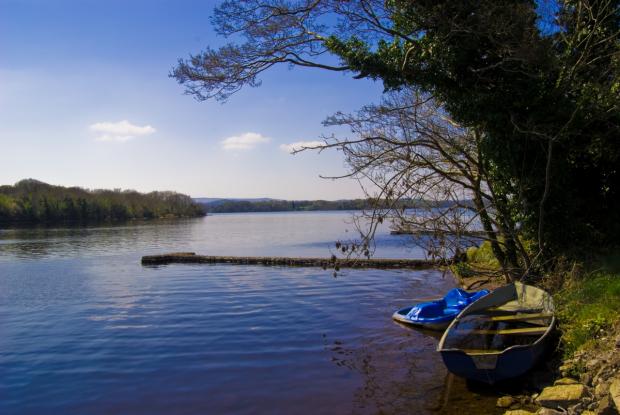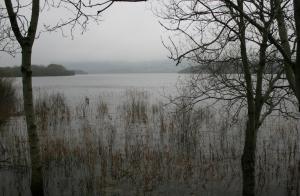Requirements of the agreement

Water levels in Upper and Lower Lough Erne are managed by control structures located at Portora (Enniskillen), Cliff (near Belleek) and Ballyshannon in the Republic of Ireland. DfI Rivers is responsible for the control structure at Portora only. During the summer period the Electricity Supply Board aims to maintain the water level at Portora, at or above, 150ft to avoid the need for these gates (locks) to be closed. This is to prevent undesirable restriction to boat traffic using the navigation facilities at this peak tourist period.
Rapid draw down of water levels in the Upper Lough is prevented by the restricted capacity of the inter-lough channel section. Allowance for this has to be made, as best as possible, in level control management procedures.

DfI Rivers record Lough Erne water levels daily at three gauging stations: Belleisle (Upper Lough Erne) approximately 22 kilometres upstream of Enniskillen; Portora (Inter-Lough channel at Enniskillen); Rosscor (Lower Lough Erne) approximately 30 kilometres downstream of Enniskillen.
| Gauging station | (1) Water level (AOD Poolbeg) Imperial (feet and inches) |
Metric (metres) |
(2) Portora sluice / Lock gate status |
|---|---|---|---|
| Belleisle (Upper Lough Erne) |
151' 03" |
46.09 |
|
| Portora (Inter-Lough Channel) |
151" 02” |
46.08 |
Gates not in operation |
| Rosscor (Lower Lough Erne) |
151' 01" |
46.06 |
Notes:
(1) Water levels shown relate to the height 'above ordnance datum' (AOD), Poolbeg. Ordnance Datum for Poolbeg is the spring tide, low water mark, of the 8 April 1837 at Poolbeg Lighthouse, Dublin.
(2) Portora Sluice and Lock Gates are put into operation when water levels fall, or are likely to fall, to 150' (45.72 metres) as measured at Portora Gauging Station in Enniskillen. When the gate status is 'In Operation', the Lock Gates are manned from 8.00 am to 10.30 pm daily to allow navigation. When the status is 'Not in Operation' navigation through Portora is unrestricted.
(3) Historic Lough Erne levels are available on request:
- email: rivers.fermanagh@infrastructure-ni.gov.uk
- post:
DfI Rivers
53 Lettermoney Road
Enniskillen
BT94 2NA
The water levels data given above are point in time, site specific levels, intended for use only in connection with the management of Lough Erne Water Levels as set out in the Erne Drainage and Development Act 1950. DfI Rivers will not be responsible for any loss or damage whatsoever arising from the use or interpretation of this information.
For queries please contact our Fermanagh Office:
- telephone: 028 6638 8529
- email: rivers.fermanagh@infrastructure-ni.gov.uk.
The office is open Monday to Friday 9.00 am to 5.00 pm.
Management of Lough Erne estate
DfI Rivers, acting on behalf of the Department for Infrastructure (formerly Department of Agriculture and Rural Development), has responsibility for managing the Lough Erne Estate which consists mainly of the bed and soil of Upper and Lower Lough Erne and, more significantly, the foreshore which was created as a result of previous schemes which lowered the lough levels.
Lough Erne report
During November 2009 County Fermanagh experienced unprecedented levels of rainfall and as a result widespread flooding which eclipsed all previously known records.
The impact was such that the Executive established a Flooding Taskforce and to identify causes and consider measures to help mitigate any future flooding. Published in July 2010 the report found that many resdients in Fermanagh felt the way the Lough Erne system was managed was a contributory factor to the flooding. Therefore, the report included a commitment by DfI Rivers to carry-out an indepth review of the operational arrangements of the Erne System which has been in place since its introduction in the 1950s.
The report also stated that the investigation should include the feasibility of bringing forward the winter drawdown of Lough levels to maximise storage.
Review of Lough Erne Operating Regime
DfI Rivers commissioned the "Review of Lough Erne Operating Regime" the aims of which were to:
- review the hydrological and hydraulic aspects of the management of flows and levels on upper and lower Lough Erne
- investigate the potential for alternative operational arrangements which might result in a reduction in flood levels, including the possibility of an earlier reduction of water levels in the autumn
The report does not include any review of the organisational arrangements such as data management, communication systems or the responsibilities assigned to particular organisations or staff within them.
Findings of the review
The review considered four alternative options for improvements to the management or the physical make-up of the Erne System, including the possibility of an earlier reduction of water levels in the Autumn. None were found to lead to major reductions in the levels, frequency or duration of floods.
The Flooding Taskforce report concluded that
"...it would not be economically or environmentally feasible to increase the capacity of the system to a level where flooding from extreme events, such as the November 2009 flooding, could be prevented. Neither would it be feasible to significantly reduce existing water levels, given the detrimental impact this would have on the natural environment and on water based tourism. "
...and stated that
"The capacity of the channels, namely the inter lough channel and the Belleek Channel, is the major restricting factor in the discharge of water from the Erne System."
The findings of the present review are consistent with those of the Taskforce report.
Despite the strongly-held convictions of many residents of Fermanagh that the main contributory factor to the 2009 flooding was the way in which the Erne system was managed, this review has found that none of the suggested changes in management leads to any significant reduction of peak levels in most floods.
